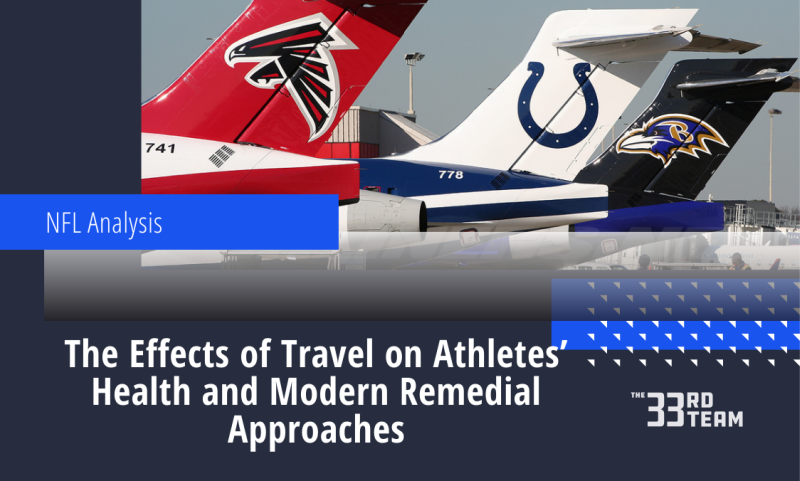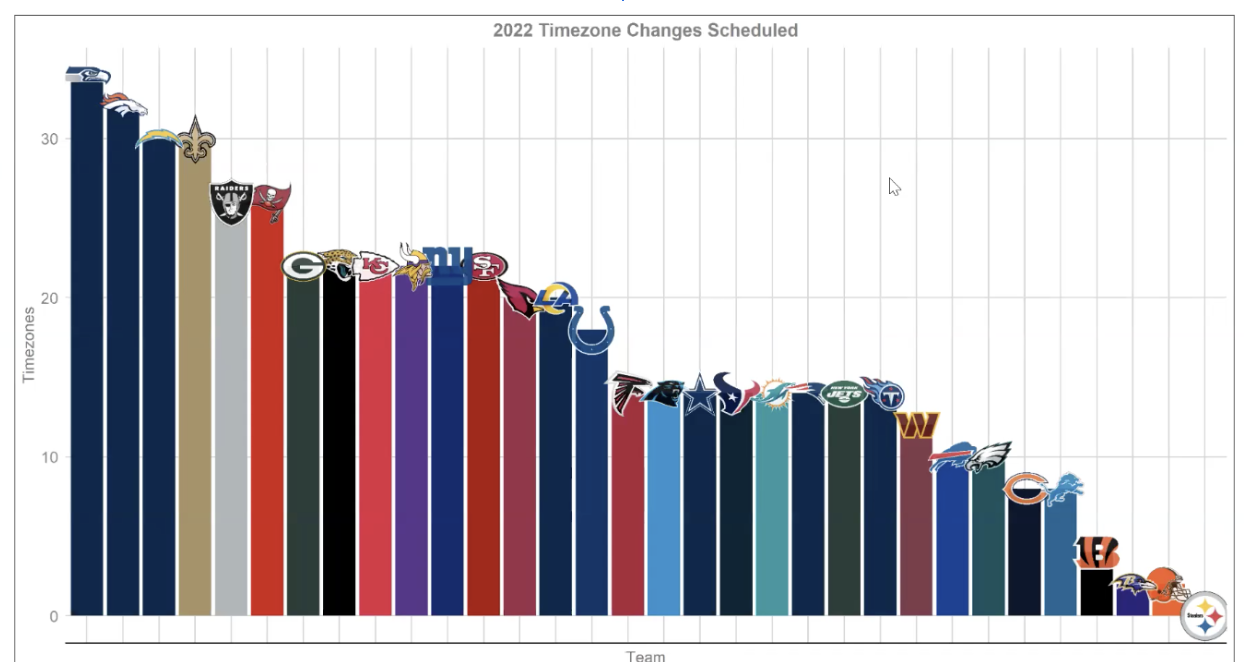Analysis
5/15/22
9 min read
Wayne Diesel: The Effects of Travel on Athletes’ Health and Modern Remedial Approaches

The NFL schedule has been released for all 18 weeks and 32 teams. Players now have a glimpse into what kind of season they're in store for from a logistical standpoint.
The NFL has also expanded its international outreach efforts, and now has a game scheduled between the Seattle Seahawks and the Tampa Bay Buccaneers in Munich, Germany on 11/11. The NFL scheduled one game in Mexico City on 11/21 (Arizona Cardinals v. San Francisco 49ers) and three in the United Kingdom (Minnesota Vikings v. New Orleans Saints, New York Giants v. Green Bay Packers, Denver Broncos v. Jacksonville Jaguars) on 10/2, 10/9, & 10/30, respectively.
Since 2007, when the international games began, there have been 33 games in 2 countries (Mexico and the UK). In 2016, the NFL began experimenting by scheduling games the week after international games for teams rather than a bye week. Teams who play the week directly succeeding the international game have a record of 3-2.
Athletes are traveling more now than they ever have, especially with the NFL’s increased presence abroad and elongated regular season. Therefore, maintaining a safe, routine, and informed plan for NFL athletes to battle the difficulties and complications of travel effects is more important than most would think. Traveling so far, so often can have detrimental effects on one’s health let alone their ability to perform on the field.
Former Miami Dolphins Director of Sports Performance and current San Antonio Spurs Director of Player Care, Wayne Diesel, joined The 33rd Team to shed some light on how travel effects athletes and how so of those effects can be mitigated.
Returning the point of whether teams should have a bye week directly after their international game, Diesel chimed in, saying, “There is not enough data available to decide whether it is a good thing to have your bye week immediately following that international travel, or to go ahead and try and play.”
It is a balancing act, because on one hand you may want to reserve the bye week for later in the season, but on the other hand, the travel involved with the international games are taxing and require a streamlined bounce-back effort from the team as a whole.
Nonetheless, it may be easier to understand the problem once you are familiar with the terminology. First, there is travel fatigue and jet lag.
“We need to touch on the differentiation between what travel fatigue is and what jet lag is now, and they both can occur,” said Diesel. “Travel fatigue tends to be something where athletes are traveling less than three hours, or going through less than three time zones. That is where they will get tired just because they are sitting on the plane.”
Diesel stressed that it is not isolated travel occurrences that do the damage, but rather the continuous stress of traveling over the course of a season.
“The frequency of travel, how long the season is, how many times they have got to fly, and how many trips they have got to do can cause fatigue,” said Diesel. “That is a more persistent type of fatigue that they have, because it is an accumulation over the whole season.
“The way that they manage that is ideally you got to look at sleep, trying to give them as much recovery as possible."
The Steelers are the only NFL team to not travel to another time zone this season, via @billsperos pic.twitter.com/VQvX5HtQoG
— FOX Sports: NFL (@NFLonFOX) May 13, 2022
Travel fatigue can be burdensome for teams on an away game stretch, but the real troublemaker can be jet lag.
“On the flip side, when you are looking at jet lag, that tends to be when you are passing through more, or at least, three time zones,” said Diesel.“So, flying to Europe is certainly going to be at least five to eight time zones [from the East Coast].
“If you are coming from the West Coast, you are going to be flying for almost 10 hours."
Jet lag is more problematic because of the drastic change in your “body clock.”
“Now, what happens with jet lag is that your body clock changes,” said Diesel. “Essentially, it is like you were set at five o’clock or six o’clock in the afternoon to 11 o’clock — your body has changed dramatically.
“Our bodies get used to waking up at certain times in the morning, going into work, having breakfast, then having lunch, then having dinner, and then going to sleep again,” said Diesel. “Tf you disrupt that, the body cycle goes out of routine.”
The question becomes, what can we do about it?
“The principal guidance is natural sunlight,” said Diesel. “What happens is that the light comes into the eye that goes into the part of the brain that stimulates a substance called melatonin.
“Melatonin is the natural sleep drug that we have. If you come into an area where you are wanting to go to sleep, you are going to suppress that as soon as you expose yourself to natural light. You know your body wants to be asleep. It is trying to find that right time and say, ‘when should I go to sleep?’”
Titans just the latest NFL team to choose a week on the road over jet lag. More from @teresamwalker: https://t.co/1n0xTUbkoI pic.twitter.com/CPl4DSZL60
— AP NFL (@AP_NFL) December 12, 2017
The next step, then, is to travel intelligently.
“The ideal situation, in some ways, if you wanted to adjust completely, you would need to fly right in the beginning of the week,” said Diesel. “Because it takes on average one day per time zone to adjust to the new time clock.
“The problem with that is you may not have the facilities available to you, because you are also putting players into a foreign environment. Like sleeping [for example], so you lose out on some of the things that would benefit you.”
Obviously, traveling on the recommended time schedule is not feasible. So, what is next?
“The compromise is that you try and leave about three days before the game,” said Diesel. “That allows you to get full practice ties in that you want in the early party of the week. Staying in their normal, natural environments and 'banking' as much sleep as they can in normal environment [is key].
“Then you’d want to arrive in the early morning when there is natural light, meaning you can get up and that will stimulate the brain. The issues are obviously that they are going to get tired, or they are going to be awake later on in the night,” said Diesel. “That is when you have other substances. You can get melatonin in tablet form that you can provide to the players to help them get to sleep.”
Particularly, the main concern is making sure the players are adjusted before game time.
“The trick is trying to get them adjusted to the new time zone and the way you do that is you give them natural light for about three hours once you have arrived in the city,” said Diesel. “Then you get them to try and go to sleep a little bit earlier, because in the evening time, they are going to be wide awake, they are going to have difficulty trying to get to sleep.”
This is where things can become complicated in our day and age.
“That is where you limit the exposure and educate them,” said Diesel. “You say, ‘Guys, look, we cannot be watching videos for long periods of time, we cannot be on our phones, because the rooms have got to be dark.'”
Another variable proven to make a difference in body temperature.
“Researchers suggested that you have to try and lower the temperature within the room,” said Diesel. “because it is when your body core temperature gets to the lowest that it helps with sleep.
“If you are warm, then you do not sleep as effectively as you do when colder,” said Diesel. “The temperature I recommend [in the room] is about 68 degrees Fahrenheit.”
Interestingly enough, sleep disorders are incredibly common among professional athletes, which can obviously have an adverse effect on performance.
“About 70% of athletes have some sort of sleep disorder, which includes sleep apnea,” said Diesel. “The medical staff should try and visit the team to find out from the players who had these issues, because that is going to come down to ‘do we have medication for these players?’”
As mentioned earlier, that is often melatonin in tablet form, but there are alternatives.
“You can give them lots of quick acting sedatives, which can help them get to sleep,” said Diesel. “You can also have stimulants, which help them keep awake.”
Now, the last piece to the puzzle is the dietary changes that can make or break a challenging travel expedition.
“I find that diet is an essential part of any recovery, really,” said Diesel. “The body gets used to a certain routine. Whenever you arrive in that new country or city, you have to try and fit those breakfast, lunch, and dinner times [into the original timeline]. Equally important than getting the time right, you have to make sure that the food you are getting to eat is compatible with what the players are used to.”
It can be so easily overlooked, but the availability of food on the go, especially in the international travel sense, can be less than ideal.
“You cannot assume that by traveling to London, Germany, or Mexico that the food is going to be the same as what these players are getting used to,” said Diesel. “One of the big side effects and negative effects of jet lag that I did not mention earlier is stomach issues or gastrointestinal issues.”
On one hand, jet lag increases dietary significance while traveling limits the availability of options for the players.
“It is important that the nutritional side of it, particularly hydration, [is being taken care of] in trying to mitigate some of those issues,” said Diesel. “Your stomach has also got its own clock, and it is used to eating at a certain time, and it is used to digesting at a certain time.
“If you then confuse the body, it may take a couple of days to come right with it. You ideally want something that is a little more carbohydrate rich, because that will put you to sleep where proteins keep you awake.”
One thing is for sure, the vigorous, non-stop traveling imputed on professional athletes and on NFL players, is something to behold. Particularly, the method to the madness behind the hustle-and-bustle is riveting and a unique insight to what it is like to travel like an NFL athlete. It will be something to keep in mind as the summer workouts start to churn and the season fires up in August and September.









